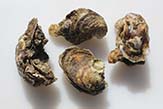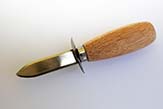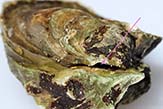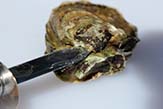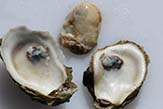Meats and Sausages
Oysters
Shellfish RecipesOyster, Eastern, Protein-5.71%, Fat-1.71%, Water-89.04%
Oyster, Eastern, farmed, Protein-5.22%, Fat-1.55%, Water-86.20%
Oyster, Pacific, Protein-9.45%, Fat-2.30%, Water-82.06%
Oysters are distributed world wide and can weigh from 35 to 100 g.
English - grow in cold water (Ostrea edulis)
Portuguese - grow in warm water (Crassostrea angulata)
Pacific - grow in warm water (Crassostrea gigas)
Olympia oysters (Pacific) - (Ostrea conchaphila)
Oysters can survive out of water for weeks if carefully handled and kept moist and cool. They should be carried and stored with the cupped half of the shell downwards, and kept moist by covering with a damp cloth. Oysters should be refrigerated out of water, not frozen, and in 100% humidity. Oysters stored in water under refrigeration will open, consume available oxygen, and die. Oysters must be eaten alive, or cooked alive. Oysters can be eaten on the half shell, raw, smoked, boiled, baked, fried, roasted, stewed, canned, pickled, steamed, or broiled, or used in a variety of drinks. Eating can be as simple as opening the shell and eating the contents, including juice. The shells of live oysters are normally tightly closed or snap shut given a slight tap. Open oysters should be tapped on the shell; a live oyster will close up and is safe to eat. Oysters which are open and unresponsive are dead and must be discarded. Cooking oysters in the shell kills the oysters and causes them to open by themselves.
Shucking (Opening)
Oyster lovers insist that the only way to enjoy them is raw, with lemon juice, vinegar, or cocktail sauce. This, of course, eliminates cooking them. Refrigerate oysters for 1 hour to help them relax. Relaxing the muscles to shuck oysters is faster if you place them in a freezer for about 15 minutes.
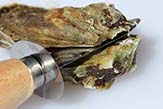
Twist the knife to break the hinge and to pry the shell apart. The knife is then used to sever the adductor muscle at its point of attachment to first the flat half of the shell, then the cupped half. Discard the top shell. Cut the muscle from the lower shell, being careful not to spill oyster liquor if the oyster is to be eaten raw.
If live oysters are to be used in a cooked dish, rather than for eating raw, you can steam them just until the shells open. Then cut them from the shells and proceed.
Smoked Oysters
Handling oyster muscle is difficult as the oysters contain around 90% of water. They are soft and slippery and easily tear apart. For these reasons it is advantageous to firm them up by brief cooking:
- Steam oyster shells for 20 minutes, then remove the oyster muscles.
- Brine oysters for 3-5 minutes in 40° brine. (Add 1.0 lbs of salt to 1 gallon of water. This makes 40 degrees brine).
- Drain and pat dry.
- Dip in oil. Drain. Place on wire mesh screen.
- Preheat smokehouse to 100-120° F (38-49° C) and dry the oysters without smoke for 60 minutes.
- Increase temperature to 180° F (82° C) and apply a heavy smoke for 30 minutes.
Smoked Oysters (Adapted from: Fish Smoking, A Torry Kiln Operator’s Handbook, Her Majesty’s Stationery Office).
A considerable proportion of the total production of oysters in Britain consists of misshapen native oysters or of Portuguese oysters that do not command the high price of quality natives. In America these second grade shellfish are frequently smoked and packed in oil to make a popular delicatessen product. The oysters which should first be cleansed to ensure that there is no risk of food poisoning from them, are steamed in a cooker for 20 to 30 minutes. The meats are then picked and brined in a 50° brine for 5 minutes. (Add 1.26 lbs of salt to 1 gallon of water. This makes 50 degrees brine).
They are quickly dipped in oil and spread on wire mesh trays. They are smoked for 30 minutes in a dense smoke at 180° F (82° C), the kiln being raised to this temperature before smoking begins. During the smoking, the oysters should be turned over, to ensure uniform smoking. The smoked meats are packed in small jars, covered with good quality edible oil, and the jars sterilized at 15 lb pressure for 15 minutes.

